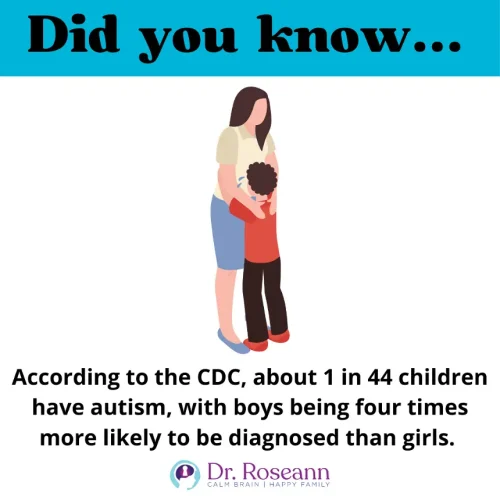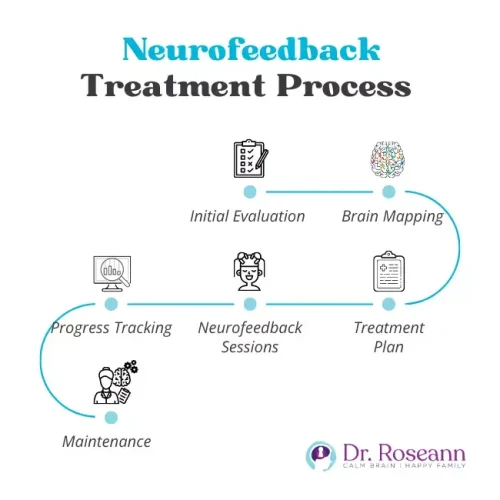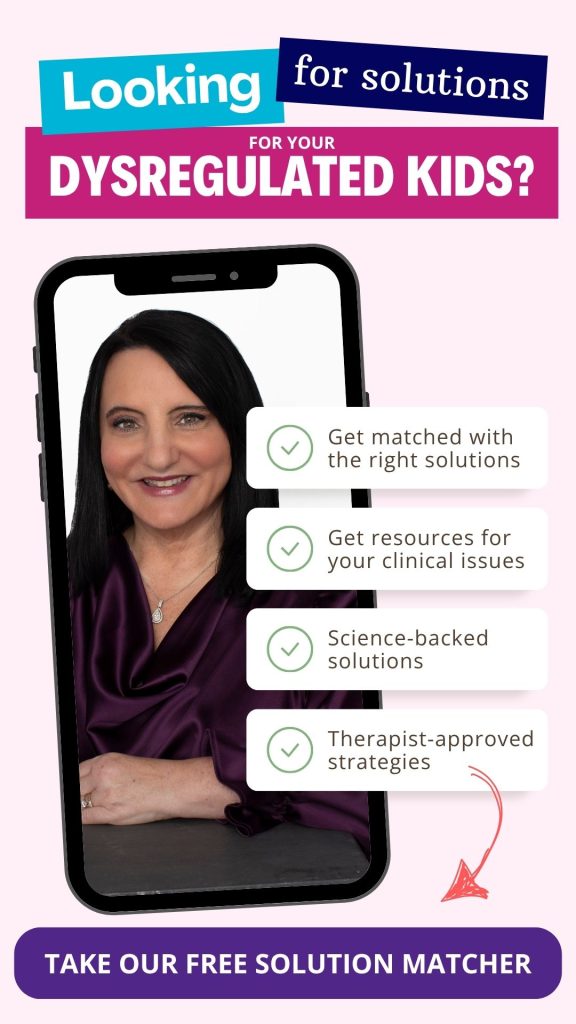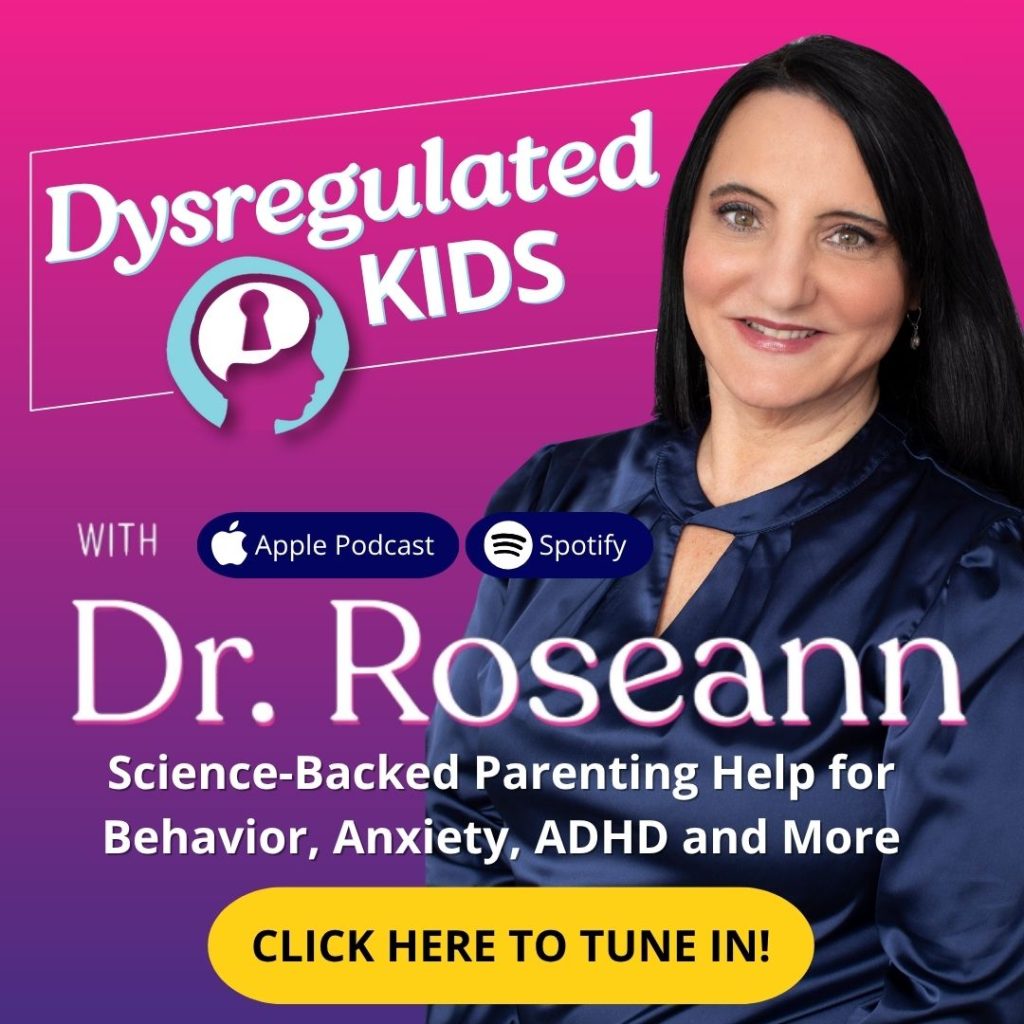Estimated reading time: 11 minutes
Parenting a child with autism can feel like a daily balancing act—where big emotions and communication struggles aren’t misbehavior, but signs of a dysregulated brain.
That’s why I use neurofeedback: a science-backed, drug-free way to calm the brain so your child can focus, regulate, and truly connect.
What is Neurofeedback and How Does It Work for Autism?
Autism Spectrum Disorder (ASD) has sharply increased—from 1 in 150 children in 2000 to 1 in 36 by 2020 (CDC.gov). With that rise comes a greater need for brain-based solutions that create real, lasting change.

That’s exactly where neurofeedback comes in.
This gentle, drug-free therapy helps the brain learn to self-regulate by targeting key areas like the:
- Amygdala
- Hippocampus
- Frontal cortex
These regions influence the following, all of which are often affected in autism:
- speech
- focus
- mood
- behavior
Backed by science and completely non-invasive, neurofeedback helps shift the brain out of overdrive and into more calm, connected patterns.
For over 20 years, we’ve supported children with autism by combining proven brain-based therapies with strong parent partnerships—to calm the brain, decode behavior, and help kids thrive at home, in school, and beyond.
What Are the Core Symptoms of Autism?
ASD is defined by core challenges in three main areas:
1. Social communication
- Trouble with back-and-forth conversations
- Difficulty reading nonverbal cues like facial expressions or tone
- Challenges with forming or even maintaining relationships
2. Repetitive behaviors
- Repeating phrases or actions (such as echolalia)
- Insistence on routines or rituals
- Strong resistance to change
3. Restricted interests
- Deep focus on specific topics or objects
- Preference for sameness
- Unusual attachments or fascinations
ASD exists on a spectrum—so symptoms vary widely. Many children also struggle with:
- Learning and problem-solving
- Language and communication
- Focus and executive functioning
- Emotional and behavioral regulation
Co-occurring conditions are common, including:
Children with autism have layered needs that impact both body and brain. That’s why we use root-cause, brain-based care to build regulation, connection, and lasting growth across all settings.
How Does Autism Impact Learning and Behavior in School?
Every child with autism is unique, but many face similar struggles in the classroom.
- Thinking and problem-solving – Slower processing can make learning feel frustrating.
- Speech and motor coordination – These foundational skills impact both academics and peer relationships.
- Social engagement – Missed cues or awkward moments can make connection hard.
- Focus and task completion – Distractions pull their brain in too many directions.
- Emotional regulation – Big feelings bubble up fast and derail the day.
I always think of Clara, a sweet girl with high-functioning autism. Her curiosity lit up every room—but even with that bright spark, staying focused and finishing tasks didn’t come easy.
To help kids like Clara thrive, schools often provide:
- IEPs or 504 Plans tailored to their needs
- Early intervention services starting in preschool
- Transition supports into adulthood based on skills and independence
When we calm the brain first, everything else—from behavior to learning—has a chance to fall into place. Because behavior is communication, and regulation opens the door to connection.
Why Do Children With Autism Often Struggle More at Home?
Many kids with autism manage their emotions at school—at least on the surface.
Here’s why:
- School routines are predictable – Transitions are structured and consistent.
- Expectations are clearly defined – Kids know what’s coming next.
- Support services are built in – Therapies, aides, and accommodations help them stay regulated.
- Social masking happens – Many kids work hard to “keep it together” around peers and teachers.
But once they walk through the door at home, things change—and fast.
At home:
- There’s less structure, which can feel disorienting.
- Unstructured time may lead to dysregulation.
- Sensory overload builds throughout the day and spills over at home.
- Parents often become the “safe space” where the child finally releases the stress.
I can’t tell you how many parents say, “It’s like my child wears a mask all day and then melts down at home.” You’re not alone—and you’re not doing anything wrong.
Why Home Can Actually Be an Advantage
Your home can also become a powerful place for healing. Here’s how you can support your child’s regulation at home:
- Stick to predictable routines – Keep things consistent, especially around transitions.
- Use visual schedules or prompts – These reduce anxiety and support independence.
- Create sensory-friendly spaces – A calm corner or weighted blanket can go a long way.
- Practice proactive regulation strategies – Breathing, movement breaks, or brain-based tools like neurofeedback.
- Lead with connection, not correction – When your child feels safe, growth is possible.
Because remember: When you calm the brain first, everything else follows.
How Does a QEEG Brain Map Help Children With Autism?
A QEEG brain map (Quantitative Electroencephalogram) is a powerful, data-backed way to understand how your child’s brain is functioning—and where it needs support.
It helps us:
- Measure brainwave activity across key regions
- Spot areas that are running too fast or too slow
- See how efficiently the brain communicates
- Identify patterns tied to emotional regulation, learning, focus, and behavior
For example, the amygdala—your child’s emotional control center—often “runs hot” in kids with anxiety, sensory overload, or mood struggles.
A brain map lets us see that, so we can support it directly instead of guessing.
What Makes Brain Mapping Different?
Unlike traditional assessments that rely on checklists or surface-level observations, a QEEG brain map gives us:
- Objective data – no guesswork, no assumptions
- Clear visuals – a real-time snapshot of how your child’s brain is working
- Neurological insight – showing brainwave patterns linked to:
- Autism
- ADHD
- Anxiety
- Executive functioning challenges
- Personalized direction – so we can target the root cause, not just manage symptoms
What Comes Next?
In our BrainBehaviorReset™ Program, a QEEG brain map is the first step. From there, I build a custom care plan based on your child’s unique brain data.
That plan often includes:
- Neurofeedback
- PEMF (Pulsed Electromagnetic Field therapy)
- Lifestyle and nutritional guidance
Each therapy is designed to support:
- Emotional regulation
- Focus and attention
- Learning and behavior
- Sleep and mood
What Happens During Neurofeedback Treatment for Autism?

Neurofeedback Process at Our Center:
- Initial Evaluation: Clinical interview + behavioral history
- QEEG Brain Map: Measures brain function + brainwave activity
- Customized Care Plan: Protocols based on your child’s brain data
- Neurofeedback Sessions: Brain feedback while watching a movie or playing a game
- Progress Tracking: Regular check-ins + updated brain maps
- Maintenance Plan: Ongoing support or boosters if needed
When the brain starts to regulate, it gets rewarded—teaching it to return to calm again and again.
How Does Neurofeedback Help Autism Symptoms?
Oliver, a teen on the spectrum, used to echo everything he heard—that was how he connected. But after starting neurofeedback, his speech began to shift, and real conversations followed.
The change felt big, but really, it was his brain learning how to regulate. Neurofeedback rewards calm, focused brainwaves until that new pattern sticks.

Here’s how it helps:
- Stress, Anxiety, Mood, and Depression – Balances brainwaves for steadier, calmer emotions.
- Obsessive-Compulsive Behaviors, Tics, and Stimming – Reduces repetitive behaviors by promoting brain stability.
- Emotional and Behavioral Outbursts – Strengthens regulation so kids can handle stress more calmly.
- Hyperactivity and Impulsivity – Sharpens control by improving the brain’s braking system.
- Inattention – Boosts focus by training the brain to stay alert and engaged.
By calming overactive patterns and strengthening underactive ones, neurofeedback supports improvements in attention, learning, mood, and even social connection (Mekkawi, 2021).
What you see as behavior is really brain dysregulation. Let’s teach the brain a better way.
How Many Neurofeedback Sessions Are Needed for Autism?
Every child’s brain is wired a little differently, which means their path to progress is going to be different too. That said, there are some patterns we see over and over with families we work with.
- Frequency: Most children attend 2 to 3 times per week.
- Duration: The usual program lasts at least 6 months.
- Personalization: A qualified provider will look at your child’s unique brain map and how their nervous system responds to each session before making a personalized plan.
Neurofeedback isn’t a quick fix—but once the brain starts finding that calm, focused rhythm, things start to shift in powerful ways. Calm the brain first, everything follows.
Why Choose EEG-Guided Neurofeedback Over Brain Training Apps?
Not all brain training is created equal—and when your child is struggling, precision matters.
Here’s how EEG-guided neurofeedback stands out:
1. Targeted Support
EEG neurofeedback targets brain areas linked to behavior, emotions, and communication—not just overall activity.
2. More Than Just Connectivity
Unlike generic apps that boost overall connectivity, this method actually helps balance the parts of the brain that drive your child’s day-to-day struggles.
3. Personalized and Precise
This isn’t a one-size-fits-all approach—it’s tailored to your child’s unique brain, offering a path that’s both more effective and more sustainable.
Because behavior is just the symptom—regulation is the solution.
What are the Factors That Influence Neurofeedback Success?
Neurofeedback can be transformational—but a few key factors make all the difference in how well it works:
- Diet and nutrition
- Underlying medical or mental health conditions
- Past brain injuries
- Consistency with sessions
- Following your provider’s recommendations
Every brain is different, but when we support it from all angles, the results can be remarkable.
What Does the Research Say About Neurofeedback and Autism?
“Does neurofeedback really work for autism?” It’s one of the top questions we hear from parents who’ve tried everything—yet still feel like their child is stuck.
Neurofeedback has been studied for decades and backed by over 3,000 peer-reviewed studies, showing significant impact for children with autism (Carrick et al., 2018; Zivoder et al., 2015).
Here’s what the research tells us:
- It Improves Functional Connectivity
Infra-Low Frequency neurofeedback improved brain connectivity in a 5-year-old with ASD, leading to better sleep, mood, and physical well-being after 26 sessions (Rauter et al., 2022).
- It Modifies Brainwave Activity
In a study on high-functioning autism, just 18 sessions of neurofeedback led to reduced theta/beta ratios and increased gamma activity—both associated with improved focus and cognitive flexibility (Wang et al., 2016).
- It Boosts Executive Function
Using real-time fMRI neurofeedback, researchers helped individuals with ASD train the left dorsolateral prefrontal cortex. This resulted in better decision-making, planning, and emotional self-regulation (Pereira et al., 2024).
- It Supports Broad Behavioral Gains
A 2024 systematic review found that neurofeedback reduces repetitive behaviors, improves social communication, and helps children better manage emotions—key challenges for those with autism (Salemi & Saffarinia, 2024).
When we regulate the brain, everything else can start falling into place.
Because what looks like behavior is often just dysregulation. And with the right support, the brain can learn a better way.
Is Neurofeedback Safe for Children With Autism?
Yes—neurofeedback is safe and effective. And for parents searching for real solutions, that’s comforting to know.
- It’s non-invasive and completely drug-free
- There are no known lasting side effects
- Backed by decades of research and clinical use
- Tailored to your child’s unique brain and needs
At our Ridgefield, CT clinic, we use neurofeedback to help parents:
- Calm their child’s brain
- Improve behavior
- Ease family stress
We also offer remote sessions for families everywhere. Through our BrainBehaviorReset™ Program, we guide families of children with ASD toward those same goals.
With over 30 years of experience—and as a team who deeply understands autism from personal and professional perspectives—we want you to know you don’t have to do this alone.
Parent Action Steps
FAQs
Can neurofeedback be done remotely?
Yes. Many clinics, including ours, offer remote sessions, allowing families worldwide to access effective neurofeedback treatment from home.
What makes EEG-guided neurofeedback different from other brain training methods?
EEG-guided neurofeedback targets specific brain regions related to your child’s unique struggles, rather than just improving overall brain activity, making it a more precise and effective treatment.
Are there any side effects I should watch for during neurofeedback?
Most children tolerate neurofeedback very well, but some may experience temporary fatigue or mild headaches, which usually resolve quickly.
Citations:
Carrick, F. R., Pagnacco, G., Hankir, A., Abdulrahman, M., Zaman, R., Kalambaheti, E. R., Barton, D. A., Link, P. E., & Oggero, E. (2018). The Treatment of Autism Spectrum Disorder With Auditory Neurofeedback: A Randomized Placebo Controlled Trial Using the Mente Autism Device. Frontiers in neurology, 9, 537. https://doi.org/10.3389/fneur.2018.00537
CDC (2022). Data & Statistics on Autism Spectrum Disorder https://www.cdc.gov/ncbddd/autism/data.html
CDC (2023). Data & Statistics on Autism Spectrum Disorder. https://www.cdc.gov/autism/data-research/index.html
Mekkawi L. (2021). Efficacy of neurofeedback as a treatment modality for children in the autistic spectrum. Bull Natl Res Cent, 45(1):45. https://doi.org/10.1186/s42269-021-00501-5
Pereira, D. J., Morais, S., Sayal, A., Pereira, J., Meneses, S., Areias, G., Direito, B., Macedo, A., & Castelo-Branco, M. (2024). Neurofeedback training of executive function in autism spectrum disorder: distinct effects on brain activity levels and compensatory connectivity changes. Journal of neurodevelopmental disorders, 16(1), 14. https://doi.org/10.1186/s11689-024-09531-2
Rauter, A., Schneider, H., & Prinz, W. (2022). Effectivity of ILF Neurofeedback on Autism Spectrum Disorder—A Case Study. Front. Hum. Neurosci. 9. https://pmc.ncbi.nlm.nih.gov/articles/PMC9219907
Salemi, M., Saffarinia, M. (2024). The Effectiveness of Neurofeedback on Improving Social Interactions and Activity of Daily Living in Children with Autism Spectrum Disorder: A Narrative Review. Journal of Health Reports and Technology. https://doi.org/10.5812/jhrt-143981
Wang, Y., Sokhadze, E., El-Baz, A., Li, X., Sears, L., Casanova, M., & Tasman, A. (2016). Relative Power of Specific EEG Bands and Their Ratios during Neurofeedback Training in Children with Autism Spectrum Disorder. Front. Hum. Neurosci. 9. https://doi.org/10.3389/fnhum.2015.00723
Zivoder, I., Martic-Biocina, S., Kosic, A. V., & Bosak, J. (2015). Neurofeedback application in the treatment of autistic spectrum disorders (ASD). Psychiatria Danubina, 27 Suppl 1, S391–S394. Retrieved from https://pubmed.ncbi.nlm.nih.gov/26417802
Dr. Roseann is a mental health expert in neurofeedback who frequently is in the media:
- The Holistic Counseling Podcast Therapist’s Integrative Tools: Neurofeedback and Biofeedback
- Life’s Essential Ingredients Connecting at the Root
- It’s Gonna Be OK! With Dr. Roseann Podcast: Neurofeedback Series
- Mel Robbins Show: Neurofeedback
- Clearly Clinical Podcast: Neurofeedback
- Autism in Action Podcast: Neurofeedback
Always remember… “Calm Brain, Happy Family™”
Disclaimer: This article is not intended to give health advice and it is recommended to consult with a physician before beginning any new wellness regime. *The effectiveness of diagnosis and treatment vary by patient and condition. Dr. Roseann Capanna-Hodge, LLC does not guarantee certain results.
Are you looking for SOLUTIONS for your struggling child or teen?
Dr. Roseann and her team are all about science-backed solutions, so you are in the right place!
Grab your complimentary copy of











